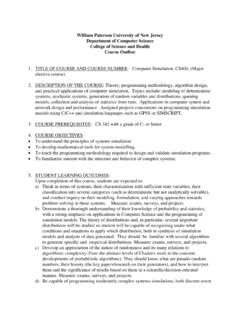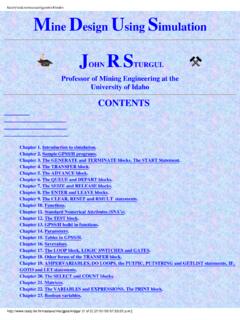Transcription of Chapter 4 Simulation Software
1 Chapter 4 Simulation SoftwareBanks, Carson, Nelson & NicolDiscrete-Event System SimulationOutline and PurposeOutline and Purpose Discuss the history of Simulation Software . Discuss features and attributes of Simulation Software , organized into three categories: General-purpose programming languages Generalpurpose programming languages, Flexible and familiar. Well suited for learning DES principles and techniques , C, C++, and Java. Simulation programming language, , GPSS/HTM, SIMAN V and SLAM II . Simulation environment Good for building models quickly Provide built-in features ( , queue structures) Graphics and animation provided E g : Arena Automod2 : Arena, Automod.
2 History of Simulation SoftwareHistory of Simulation Software3 History of Simulation SoftwareHistory of Simulation Software 1995 - 60 The Period of Search Search for unifying concepts and the development of reusable routines to facilitate Simulation . Mostly conducted in FORTRAN 1961 - 75 The Advent Appearance of the forerunners of Simulation programming languages (SPLs )languages (SPLs.) The first process interaction SPL, GPSS was developed at IBM 1966 - 70 The Formative Period Concepts were reviewed and refined to promote a more consistent representation of each language s worldview4 Sources: Nance (1995) and panel discussion at the 1992 Winter Simulation conference (Wilson, 1992).
3 History of Simulation SoftwareHistory of Simulation Software 1971 - 78 The Expansion Period Major advances in GPSS came from outside IBM Major advances in GPSS came from outside IBM GPSS/NORDEN, a pioneering effort that offered an interactive, visual online environment (in Norden Systems.) GASP added support for the activity-scanning worldview and event-scheduling worldview (at Purdue.)scheduling worldview (at Purdue.) 1979 - 86 The Period of Consolidation and Regeneration Beginnings of PSLs written for, or adapted to, desktop computers and microcomputers. Two major descendants of GASP appeared: SLAM II and SIMAN Two major descendants of GASP appeared: SLAM II and SIMAN (provide multiple modeling perspectives and combined modeling capabilities).
4 1987 Now The Period of Integrated EnvironmentsGth f SPLthltd thf Growth of SPLs on the personal computer and the emergence of Simulation environments with graphical user interfaces, animation and other visualization tools. Recent advancements have been made in web-based : Nance (1995) and panel discussion at the 1992 Winter Simulation conference (Wilson, 1992).Selection of Simulation SoftwareSelection of Simulation Software Advice when evaluating and selecting Simulation ftsoftware: Consider the accuracy and level of detail obtainable, ease of learning, vendor support, and applicability to your applications. Execution speed is important. Beware of advertising claims and demonstrations.
5 Ask the vendor to solve a small version of your problem. Ask the vendor to solve a small version of your Simulation SoftwareSelection Simulation Software Model building feature Runtime environment Animation of layout featuresy Output features Vendor support and product pppdocumentation7 Model building featureModel building feature Modeling world-viewIt d tl ibilit Input data analysis capability Graphical model building Conditional routing Simulation programming Syntax Input flexibility Input flexibility Modeling conciseness RandomnessSilidt dt lt Specialized components and templates User-built objects Interface with general programming language8 Runtime environmentRuntime environment Execution Speed Model size.
6 Number of variables and attributes Interactive debugger Model status and statistics9 Animation of layout featuresAnimation of layout features Type of animationItdi dbjtfil Import drawing and objects file Dimension Movement Quality of motion Libraries of common objects Navigation Navigation Views Display stepSl tbl bj t Selectable objects Hardware requirments10 Output featuresOutput features Optimizationp Standardized Report Statistical Analysis Statistical Analysis Business Graphic File Export Database11 Vendor support and product documentationVendor support and product documentation Training Documentation Help systemy Tutorials Supportpp Upgrades, maintenance Track reportTrack report12 Selection of Simulation SoftwareSelection of Simulation Software Advice when evaluating and selecting Simulation ftsoftware: Beware of checklists with yes and no as the entries, many packages claim to have a conveyor entity, however, implementations have considerable variation and level of fidelity.
7 Determine whether the Simulation package and language are sufficiently powerful to avoid having to write logic in any external language. Beware of no programming required, unless either the package is a near-perfect fit to your problem domain, or programming is possible with the supplied blocks, nodes, or process-flow diagram. 13An Example SimulationAn Example Simulation The checkout counter: a typical single-server queue The Simulation will run until 1000 customers have been served. Interarrival times of customers ~ Exp( min). Service times are (approx.) ~ Normal( min, min).(pp)() When the cashier is busy, a queue forms with no customers turned away. Manual Simulation in Manual Simulation in Examples Two events: the arrival and departure events (logic illustrated in Figures and ) This example is used to illustrate simulations in Java, GPSS/H and SSF in the following ViewGlobal View Customer being served (in server) Arriving customer Server Departing customer Customers are waiting to be served (in queue) System 15 Event-scheduling/time-advance algorithmEventscheduling/timeadvance algorithm16 Simulation in JavaSimulation in Java Java is widely used programming language that has bdtiliiltibeen used extensively in Simulation .
8 It does not provide any facilities directly aimed at aiding the Simulation Simulation analyst. The runtime library provides a random-number generator. It supports modular construction of large models. Simulation libraries such as SSG alleviate the development burden. Provides access to standardized Simulation functionality and hide Provides access to standardized Simulation functionality and hide low-level scheduling in JavaSimulation in Java Discrete-event Simulation model written in Java contains the following :following : Basic components: System state Entities and attributes Sets Events Activities Delaysy Common components (when organizing model in a modular fashion by using methods): ClockInitialization method Initialization method Min-time event method Event methods Random-variate generators18 Main program Report in Java:in Java: The overall structure of Java Simulation is: Simulation is:19 Single-Server Queue Example.
9 [Sil tii J][ Simulation in Java] The overall structure of Javastructure of Java Simulation structure of the grocery checkout tlcounter example:20 Single-Server Queue Example[ Simulation in Java] The main program:21 The Checkout Counter:VariablesThe Checkout Counter: VariablesSystem stateQueueLength ,NumberInServiceEntity attributes and setCustomersFCFS queue of customersFuture event ListFutureEventListActivity durationsMeanInterArrivalTime, MeanServiceTimeInput parametersMeanInterArrivalTime, MeanServiceTime, SIGMA standard deviation, TotalCustomers(The stopping criterion) Simulation variablesClockStatistical accumulatorsLastEventTime ,TotalBusy, Max QueueLength, SumResponseTime, NumberOfDepartures ,LongServicewho spends 4 or more minutes22pSummary statisticsRHO=BusyTime/ClockProportion of time server is busyAVGR average response time ,PC4proportion of customerswho spent 4 or more minutesThe Checkout Counter.
10 Functions and MthdMethodsexponential(mu)Functionsnorma l(mu,SIGMA)InitializationMethodsProcessA rrivalProcessDepartureProcessDepartureRe portGeneration23pSingle-Server Queue Example[ Simulation in Java] Structure of the main program:classSim{// Class Sim variablespublic static doubleClock,MeanInterArrivalTime,MeanSer viceTime,SIGMA,LastEventTimeLastEventTim e,TotalBusy,MaxQueueLength,SumResponseTi me;public static longNumberOfCustomers,QueueLength,Number InService,TotalCustomers,NumberOfDepartu res,LongService;blfllpublicfinalstatic intarrival=1;public final static intdeparture=2;public staticEventList FutureEventList;publicstaticQueueCustome rs;publicstaticQueueCustomers;public staticRandom stream.}









